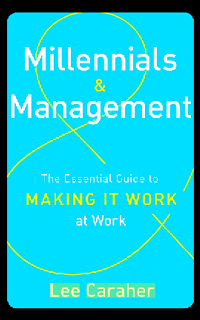By understanding what our younger colleagues hope to get from their work, we can harness the energy, brain power and tech savvy they bring to the table.
Reviewed by Allan Fallow

Sick of reading about baby boomers? If so, you’ll embrace this guide on how to peacefully co-exist in the workplace with millennials — the 77-million-strong population bulge of Americans born from 1980 to 2000.
Author Lee Caraher punctures certain stereotypes about millennials (that they’re entitled, presumptuous slackers, for starters) while confirming others: They do need constant feedback, they do expect organizational transparency and access to the top tiers of management, and they have been known to anticipate recognition merely for showing up.
If you’re 40 to 65 years old today, you may be looking at another 10 to 35 years on the job! So wake up and smell the Red Bull, people: “Now is the time to find a way to work more productively with the younger cohort,” writes Caraher. “To ignore this opportunity is to consign yourself to misery.”
Personal experience inspired Caraher to write Millennials & Management. As head of the San Francisco marketing agency she founded in 2002, the author recalls the day she hired her first millennial in 2008 as “a watershed moment”: The young woman’s work was “fantastic,” recalls Caraher, but she brought her dog to work unannounced, then “asked for four weeks off before her wedding — five weeks before the wedding.”
Later in the book, Caraher reveals that she had to double as a sort of managerial Miss Manners at times, teaching millennials why common courtesies such as “please” and “thank you” are non-negotiable elements of official texts and emails.
Strategic Advantage
But Caraher’s not here to hector any particular cross-section of today’s workers, be they boomers (the generation born 1946–1964), Gen Xers (1965–1979), or millennials. With millennials now constituting half of the staffers at her 30-person agency, Caraher spends “a good chunk of time advising companies on how to work with, communicate with and market to millennials.” Even the least forward-thinking executive, she says, should be able to understand why making the most of a generationally diverse workforce is no longer just a nice-to-have: “Those companies that become places where millennials are welcomed and appreciated will have a significant strategic advantage over the competition.”
To research Millennials & Management, Caraher surveyed and interviewed hundreds of employees nationwide in a broad range of industries. Their verbatim quotes pepper the pages of this no-nonsense business guide, whose chapters conclude with counterbalancing lists of “Management Do’s and Don’ts” and “Millennial Do’s and Don’ts.” Among the former, my favorite has to be, “Don’t ever say, ‘You’re too young to know…’ unless you want people beating a path to the exit door.” Among the latter, it’s “Don’t be upset if the person you want to see can’t see you right away. People are busy for a reason, and that reason most likely has nothing to do with you.”
Here’s What Works
So, what do under-35s hope to get from their jobs in 2015? First, they want to do meaningful work. Second, they want to understand how their role advances the company’s mission or bottom line over the long haul. Third, they want to see evidence that their ideas are being heeded — and possibly even put into practice. Fourth, millennials put a premium on fitting in with whatever team they are joining. Fifth, they seek regular feedback on, and appreciation of, their work.
The book’s later chapters explain how transparency can build employee engagement; why flextime and work-life balance can give your company an edge (and keep new hires from streaming out its doors); and what organizational hierarchies mean to millennials (hint: not much).
Charting the shifting sands of intergenerational office dynamics must have been a heavy lift for the author, who describes herself as “Chief Bacon Officer” in the Caraher household because her husband — “Chief Home Officer” Pete — job-shares in order to care for the couple’s developmentally disabled younger son. But she neatly pulls off that feat in Millennials & Management by sketching broad labor trends and interlarding them with specific coping schemes. Let me leave you with a handful of my favorites — which, incidentally, I think qualify Caraher for a second title: Wise Woman of the Workplace.
- If you’ve gone back and forth on an issue in IM more than four or five times, for God’s sake stop typing and pick up the phone to resolve it with the other person.
- Given that “sitting is the new smoking,” consider instituting a 30-minute “Walk ’n’ Talk” each week to encourage millennials to pitch you new ideas. “By walking side by side instead of sitting across a desk or table, you remove the stress of having to look the boss in the eye while sharing thoughts.”
- To curb outbreaks of Impulse Control Disorder on your organization’s email platform, dial the “Send Delay” function up to five minutes. This lets you retrieve those ill-advised instances of “oversharing” when you need to.
- Mentorships should go both ways: “If you continue to be flummoxed by Instagram or Pinterest, or don’t know how to use Facebook or blog comments to your advantage, consider having a millennial colleague or acquaintance mentor you for a month or two.”
- Assume that every millennial who works for you has Google News Alerts primed to ping them when something pops about your company or its executives. In the New World Order of work, this means you must communicate “good news, neutral news, and bad news early and often — it’s like voting in Chicago.”








